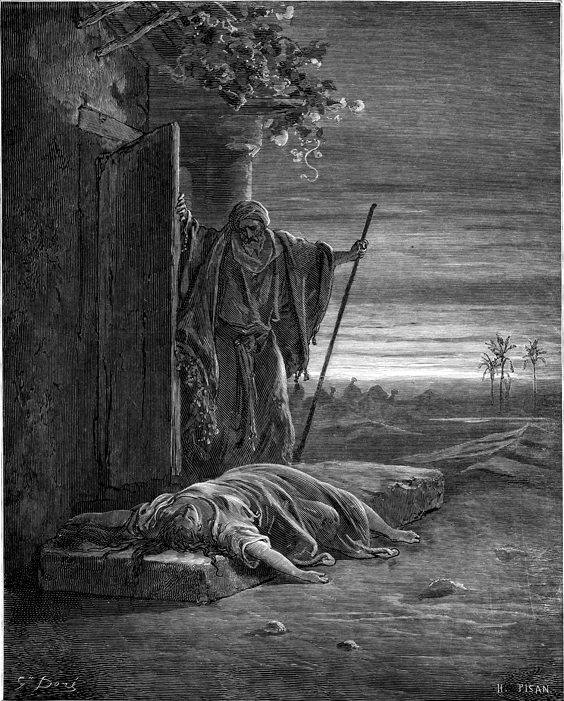Why the Levite Cut Up His Concubine in Judges 19

Having recently taught Judges 19 (the story about the Levite and his concubine) to a group of women who were keen to study their Bibles, I was asked afterward why the Levite would cut up his concubine. Further, what was the reason the Levite sent the pieces of the concubine to the other tribes? These are good questions, and after having done a little more research on the issue I wanted to provide some of my thoughts.
First, it is evident that the story of the Levite and his concubine in Judges 19 is one of the most gruesome and tragic chapters in all of Scripture! The details of the story are intentionally crafted to chronicle the Canaanization of Israel for the reader. After reading the chapter, one cannot help but be struck by the wickedness of the people of Israel. They are not just wicked, but they have reached the utter depravity that characterized the Canaanites and led to their expulsion from the land (cf. Lev 18:26-30). Unless Israel receives divine help, the book of Judges is telling us they are in major trouble!
What about the Levite’s actions of cutting up his concubine?
First of all, the Levite cutting up his concubine is meant to be seen as a gruesome and heinous act! Nowhere in biblical law or narrative do you have anything resembling this grotesque act. In fact, this disregard for proper burial of the concubine would have been egregious to those in the ancient Near East and should have especially been so for Israelites who were to bury even criminals (cf. Deut 21:23). The fact that this man was a Levite (a spiritual leader) is all the more shocking! The way in which he treated his concubine is quite instructive to the reader about how wicked and calloused Israel has become.
Second, although the cutting up of the concubine is nowhere explained, the closest biblical parallel is found in 1 Samuel 11. In 1 Samuel 11, Saul is overcome by the Spirit of God when he heard about the suffering of Jabesh-gilead (1 Sam 11:5-6). As a result, he cuts up two oxen and sends their pieces throughout Israel. However, we are not told that there was one piece sent to each tribe (as is implied with regard to the concubine in Judges 19). Rather, it seems that Saul simply sent out multiple pieces throughout the territory of Israel.
A further difference in the narratives is that in 1 Samuel 11 Saul includes a threatening message with the pieces of oxen—“Whoever does not come out after Saul and Samuel, so shall it be done to his oxen!” (v. 7). This message may be implied in Judges 19, but it is not explicitly stated.
Based on the comparison of Judges 19 and 1 Samuel 11, perhaps we can say that the action of dismembering and sending out 12 pieces of the concubine was meant to induce shock and anger. It certainly seems that in both Judges 19 and 1 Samuel 11, the people respond with shock and unity. At the very least, the uniqueness of the act grabs the people’s attention in a way nothing else could.
Perhaps we get more understanding into why the Levite cut up his concubine from an extrabiblical parallel. We seem to have such a parallel to Judges 19 found in the texts from the excavations at Mari (Tell Ḥarı̄rı̄). The text is a letter from Baḫhdi-Lim to a king, Zimri-Lim (ca. 1800–1775 BC).
To my lord, speak. Baḫhdi-Lim your servant [speaks] as follows: For five full days I have waited for the Hanaeans but the people do not gather. The Hanaeans have arrived from the steppe and established themselves among the settlements. Once, twice, I have sent [word] to the settlements and the appeal has been made. But they have not gathered together, and for the third day they have not gathered. Now, if I had my way, a prisoner in jail should be killed, his body dismembered, and transported to the area between the villages as far as Hudnim and Appan in order that the people would fear and gather quickly, and I could make an attempt in accordance with the command which my lord has given, to carry out the campaign quickly.
(Cited in Block, Judges, Ruth, 546).
We can readily note the similarity here with the account of the concubine in Judges 19. Importantly, this extrabiblical text gives the purpose for this action—the expectation that “the people would fear and gather quickly.”
What this seems to communicate is that the practice of dismemberment was at least known in the ANE. In 1 Samuel 11, oxen (legitimate sacrificial animals) were cut up and sent out as legitimate sacrificial animals. However, in contrast, by dismembering his concubine (a human being made in the image of God), the Levite appears to be appropriating a practice from the pagan nations—in a similar vein to human sacrifice!
Thus from start to finish the story of the Levite and his concubine is a discouraging tale of the paganization of Israel. It is fascinating that throughout the story the concubine remains silent, never saying a word. Yet, it is the concubine who tells the story so clearly—Israel is in trouble and is in desperate need for God’s sovereign and gracious intervention.
One Comment
Mg
Great discovery! I am a 12yrl girl that wants to get to know Jesus and read the bible- when I read this story I thought, “Reading this, what happend to Lot and his daughters in the cave is not that grusome anymore!” The story was truly shocking and I thought “Why would anyone put that?” Then reading this I was amazed by what this story actually means! You did such a amazing job explaining this! Keep going Jesus loves you!